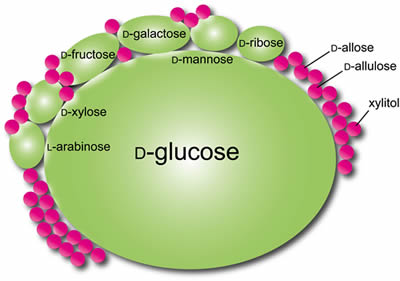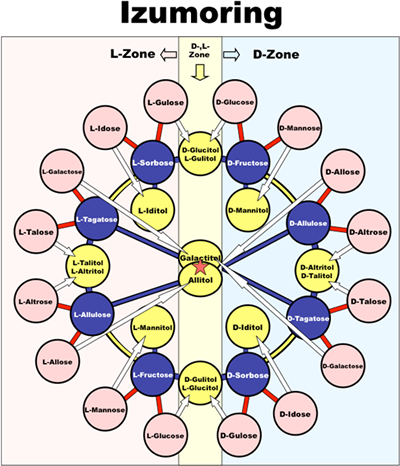Research Outline
Innovation of New Field in Life Science.
The 21st century is called the century of Biotechnology. Rapid development of researches with DNA and protein analyses has been showing a huge contribution to the global community. While the "macromolecules" of DNA and proteins are leading the science of the 21st century, Kagawa University focuses on a "micromolecule" of rare sugars, which has never been paid an attention for a long time. Small molecules such as monosaccharides had been considered as "nonfunctional" other than energy sources and less meaning in signal transduction pathways in living beings until our series of findings of unexpected functions and roles of rare sugars.
Under a background of these circumstances, Kagawa University strengthens an innovation of the new face in life sciences using rare sugars as a research tool. The figure below shows the abundance of monosaccharides of the natural world schematically. The large green parts are existing monosaccharides in the natural world, and the small red circles indicate "rare sugars" with the definition of monosaccharides and their derivatives being rarely found in nature by the International Society of Rare Sugars. Headquarter of the International Society of Rare Sugar is located in Kagawa University, Kagawa, Japan.

Kagawa University pushes forward various types of rare sugar studies in cooperation with research institutions and companies in the world with our aim of an innovation of the new face in life sciences using rare sugars as a research tool.
Rare Sugar Production
Since rare sugars are defined as monosaccharides and their derivatives being rarely found in nature, production of rare sugars is the essential first step to start rare sugar studies. The things necessary for production of various kinds of rare sugar are affordable raw materials, production tools, and a blueprint design of the production.
The most affordable raw material is D-glucose, which is the most abundant monosaccharide exists on the earth and can easily be obtained by hydrolysis of starch. However, a new source of raw material for rare sugar production can be developed with a progress of research.
An enzyme is a basic tool for rare sugar production and various updated biotechnology has been adapted for this processes. Additional tool is sugar organic chemistry, and the combined technology of enzymology and organic chemistry gives a powerful tool on rare sugar production with many aspects.
A blueprint design of rare sugar production starts from D-glucose following multiple series of enzymatic reactions and is summarized as "Izumoring". The figure below shows carbon six Izumoring but the Izumoring is also able to expand for even carbon five or four as well.

Izumoring
Izumoring, a blueprint design of rare sugar production, describes enzymatic reactions to produce aldose (●) , ketose (●), and sugar alcohol (●). All hexoses lined up as a point symmetry from the central star, and left side is D-form as well as L-form in the right side.
Izumoring navigates the production method of a target rare sugar. For example, a plan to produce D-allulose starts from D-glucose at the right top following two enzymatic reactions to D-fructose and the final product.
Important point of [zumoring] is that [zumoring] is not only a simple design of producing rare sugars but also a useful tool based on their structures in bundling of multiple information such as expansion of sugars to modified sugars, physical characters of respective rare sugars, and even functions of the sugars. Production of deoxy sugars at carbon one or six position can be introduced by deoxy Izumoring. Physical characters and physiological functions of respective sugars can also be added to physical Izumoring or physiological Izumoring, and there is always a possibility to analyze the information with the correlation of respective rare sugar structures.
Application Development of Rare Sugars
Because the study of rare sugars has just begun, application development is expected to grow more and rapidly. Kagawa University started a challenge for an innovation of new face in life sciences using "micromolecule" of rare sugars as a research tool, while "macromolecules" of DNA and proteins are dominant research subjects.
Discoveries of physiological functions of rare sugars to microbes, plants, animals, insects, human, etc., are directly connected to application developments for economic and societal benefits in a global community. We had provided a functional sweetener composition comprising non-caloric natural sweetener such as D-allulose, and a commercialization of this had already been initiated. Without being satisfied with this one example of success, we look forward to providing more fruitful products from our findings. Direction of basic researches aiming application development is expanding more and more including physical sciences or molecular tool development, etc. Research experiences for such an innovation also guide human development as educational aspects, and a field of teaching material development was placed in the division of Application Development in our Institute.
Rare sugar production and its application development are tightly connected, and both run as two wheels for progress of rare sugar studies.
Approaches in Rare Sugar Studies
Kagawa University aims to discover the research area using rare sugars as a new tool in current life sciences, in which DNA and protein analyses have been showing a major contribution. Direction of researches is now expanding wider academic fields, and Kagawa University would like to contribute with solid scientific approaches for rare sugar studies, which was born in Kagawa, in the International Institute of Rare Sugar Research and Education.



